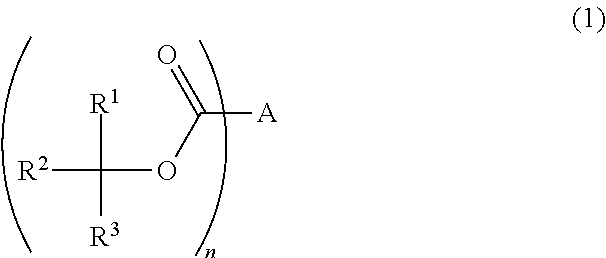Photoresist composition, resist pattern-forming method, acid diffusion control agent, and compound
- Summary
- Abstract
- Description
- Claims
- Application Information
AI Technical Summary
Benefits of technology
Problems solved by technology
Method used
Image
Examples
example 1
[0283]Into a 200 mL eggplant-shaped flask were charged 3.00 g (13.9 mmol) of N-t-amyloxycarbonyl-4-hydroxypiperidine, 2.11 g (20.9 mmol) of triethylamine, 0.034 g of dimethylaminopyridine (0.279 mmol) and 40 g of dichloromethane, and the mixture was cooled to 0° C. on an ice bath. Next, to this mixture, 3.32 g (16.7 mmol) of 1-adamantylcarboxylic acid chloride dissolved in 20 g of dichloromethane was added dropwise over 10 min. Thereafter, the mixture was stirred at 0° C. for 30 min, and then stirred at room temperature for 20 hrs. After the reaction was quenched by the addition of water, the reaction mixture was extracted with dichloromethane, followed by washing with water and purification by way of column chromatography to obtain 4.62 g of a compound represented by the following formula (i-1) (hereinafter, may be also referred to as “compound (i-1)”) (yield: 87.8%).
examples 2 to 4
[0284]Compounds represented by the following formulae (i-2) to (i-4) were each synthesized in a similar manner to Example 1 except that the corresponding other derivative was used in place of 1-adamantylcarboxylic acid chloride.
Synthesis of Polymer
[0285]Monomers used in the synthesis of the polymer (A) and the fluorine-containing polymer (E) are shown below.
Synthesis of Polymer (A)
synthesis example 1
[0286]A monomer solution was prepared by dissolving 9.01 g (50 mol %) of the compound (M-1) and 10.99 g (50 mol %) of the compound (M-2) in 40 g of 2-butanone, and further dissolving therein 0.81 g (5 mol % with respect to the total mol number of the compounds) of AIBN as a polymerization initiator. A 100 mL three-neck flask containing 20 g of 2-butanone was purged with a nitrogen gas for 30 min, and then heated to 80° C. with stirring, and the monomer solution prepared above was added dropwise over 3 hrs using a dropping funnel. The time of the start of the dropwise addition was regarded as the time of the start of the polymerization reaction, and the polymerization reaction was allowed to proceed for 6 hrs. After the completion of the polymerization reaction, the polymerization reaction solution was water-cooled to 30° C. or below. The cooled polymerization reaction solution was poured into 400 g of methanol, and the deposited white powder was filtered off. The filtered white powd...
PUM
 Login to View More
Login to View More Abstract
Description
Claims
Application Information
 Login to View More
Login to View More - R&D
- Intellectual Property
- Life Sciences
- Materials
- Tech Scout
- Unparalleled Data Quality
- Higher Quality Content
- 60% Fewer Hallucinations
Browse by: Latest US Patents, China's latest patents, Technical Efficacy Thesaurus, Application Domain, Technology Topic, Popular Technical Reports.
© 2025 PatSnap. All rights reserved.Legal|Privacy policy|Modern Slavery Act Transparency Statement|Sitemap|About US| Contact US: help@patsnap.com



